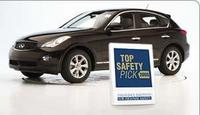Infiniti SUV Earns Top IIHS Safety Award
ARLINGTON, Va., Jan. 10, 2008; The new Infiniti EX35, a luxury SUV, earns the Insurance Institute for Highway Safety's Top Safety Pick award for 2008. The EX35 is the first Infiniti to earn this award. Top Safety Pick winners afford superior overall crash protection among the vehicles in their class. To qualify a vehicle must earn the highest rating of good in the Institute's front, side, and rear tests and be equipped with electronic stability control.
"Criteria to win are tough because the award is intended to drive continued safety improvements such as top crash test ratings and rapid addition of electronic stability control, which is standard equipment on the EX35," says Institute president Adrian Lund. "Recognizing vehicles at the head of the class for safety helps consumers distinguish the best overall choices without having to sort through multiple test results."
The number of vehicles earning Top Safety Pick is increasing. Only 13 cars, minivans, and SUVs initially qualified for 2007 awards. At the beginning of the 2008 model year, the number of winners more than doubled to 34. As automakers introduce new models or make safety changes to existing ones, the Institute adds winners throughout the year.
"The EX35 is a leader in its class for state-of-the-art safety," Lund says. "You don't know what kind of crash you're going to be in. That's why it's important to choose a vehicle that will protect you in all kinds of crashes. The Top Safety Pick designation is intended to help people find the safest choices."
In 2007 the Institute made the criteria to earn the award tougher by adding a requirement that winners must be equipped with electronic stability control (ESC). This is based on Institute research indicating that ESC significantly reduces the risk of driver involvement in crashes in the first place. Known by different names and called Vehicle Dynamic Control on the EX35, ESC helps drivers maintain control in the worst situation -- loss of control at high speed -- by engaging automatically when it senses vehicle instability and helping to bring a vehicle back in the intended line of travel, often without the driver knowing anything is wrong. ESC lowers the risk of a fatal single-vehicle crash by about half. It lowers the risk of a fatal rollover crash by as much as 80 percent.
How vehicles are evaluated: The Institute's frontal crashworthiness evaluations are based on results of 40 mph frontal offset crash tests. Each vehicle's overall evaluation is based on measurements of intrusion into the occupant compartment, injury measures recorded on a Hybrid III dummy in the driver seat, and analysis of slow-motion film to assess how well the restraint system controlled dummy movement during the test.
Side evaluations are based on performance in a crash test in which the side of a vehicle is struck by a barrier moving at 31 mph. The barrier represents the front end of a pickup or SUV. Ratings reflect injury measures recorded on two instrumented SID-IIs dummies, assessment of head protection countermeasures, and the vehicle's structural performance during the impact. Injury measures obtained from the two dummies, one in the driver seat and the other in the back seat behind the driver, are used to determine the likelihood that a driver and/or passenger in a similar real-world crash would sustain serious injury to various parts of the body. The movements and contacts of the dummies' heads during the test also are evaluated. Structural performance is based on measurements indicating the amount of B-pillar intrusion into the occupant compartment.
Rear crash protection is rated according to a two-step procedure. Starting points for the ratings are measurements of head restraint geometry -- the height of a restraint and its horizontal distance behind the back of the head of an average-size man. Seat/head restraints with good or acceptable geometry are tested dynamically using a dummy that measures forces on the neck.



